
EASY-AI English for the Workplace
Have you integrated AI-powered activities into your courses yet?
Attention, all hardworking teachers!
This course is meant for 101B (low-intermediate) and 102B (high-intermediate) students and their tired teachers. You don’t have to work quite so hard anymore. By choosing this course, you can dramatically reduce your correction load and significantly accelerate student learning.
It’s true. All of the activities in this course are automatically scored. The feedback is instant, accelerating learning by correcting errors just in time — not weeks after the fact. Students can repeat their attempts based on the feedback they have received to improve their scores, rewarding their effort instead of prior proficiency. Redoing writing assignments and redoing speaking assignments has no impact on the teacher’s workload but has a huge impact on student learning.

Automated evaluation also has a huge impact on student stress levels. Teachers can relax the deadlines into due dates. Students who fall behind can submit late without causing headaches for the teacher. Some students will even jump ahead and do the exercises early if you let them. Allowing students to learn at the their own speed and manage their workload produces a happier classroom for all.
The interactive activities in the course are not available from any other publisher. This stuff is a radical departure from the types of activities available from the big publishing houses. Check this out. Does any other publisher offer this kind of safe-space oral interactivity?
The content of this course is easy to integrate with the offline activities you already teach and is relevant to any college program. The workplace themes are universally applicable to any field of study, progressing in a logical, linear sequence from “doing well in school” to “on the job training,” and “internships,” ending with “retirement.” The topics can provide the backbone to your semester, allowing you to add classroom research projects and reciprocal teaching activities in parallel.
The course also comes with a job-interview preparation project, providing clear models of strong interview answers. The interview activities have all been piloted with more than a hundred students at the college level. The piloting teacher called the job-interview training module the “pearl” of his course, having received very positive feedback from students because they address a practical need—-job interview performance anxiety. Students are motivated to learn job-interview skills. As such, this part of the course makes an excellent online companion to a midterm/final speaking exam in which students ask each other job interview questions. Those that do the online preparation activities in this course will easily outshine the students who don’t. Say goodbye to the rambling, repetitive interview answers that make you inwardly cringe and groan.
Navigation
This course is easy to navigate. Every activity is accessible from one page. At the top of the course page, you can find the icon navigation menu. Tell your students to click on a particular icon. The webpage will reposition itself to the section containing the relevant activities. The icons correspond to doing well at school, on the job training, internships, volunteering abroad, etc.. Jump to the next section by hitting the spacebar. Ask the students to start the activities in the lab and finish what’s left for homework.
There are level confirmation activities at the beginning of the course and job interview activities at the end. The blue box in the bottom right corner of the page returns the browser to the top of the page.

Gradebook
The gradebook is arranged into 6 categories: Level confirmation 0%, Writing 30%, Listening 30%, Virtual dialogues 10%, Workplace narrative orals 10%, and Interview preparation 20%. You can find the gradebook by clicking on the hamburger menu (1) in the top left. Click the gradebook setup tab (2). You can change the weighting of each section by changing the number in the box (3) in the “Weights” column. And you can change the label for each gradebook category by clicking on “Edit” (4). Note that you can also change the “best of” scoring to make the system more generous.
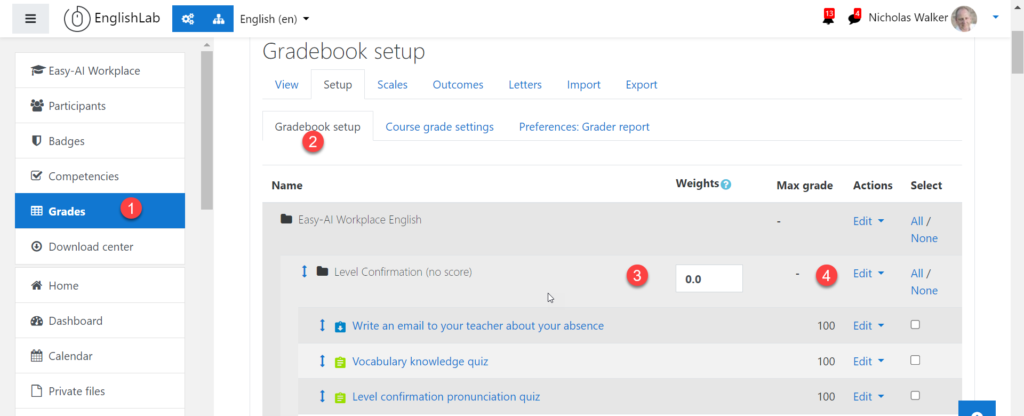
Consider counting the Labodanglais portion of your course as 50% of your course total, and counting finals and offline projects as the other 50%.
Content
The first section of the course, intended to support teachers during Week 1 of the semester, contains a fluency-based speaking activity that students can access on their phones in the classroom. It also contains diagnostic pronunciation, vocabulary, and writing activities.

This last activity uses a large language model to identify errors and classify the student’s writing based on proficiency. As you can see below, the errors in the sample text that I submitted have been highlighted in red. Underneath, the system explains the errors and classifies this particular text as a low-beginner text because of its error density.

Activity Sequence and Anticipated Difficulties
Each lesson is sequenced as follows: a timed listening quiz, a virtual dialogue with a robot, a narrative writing assignment, and a webcam oral assignment. Each assignment is automatically scored and generates a score in the gradebook. When an activity has been completed, a green checkmark appears next to the activity on the course page to let the student know what has been done and what hasn’t.
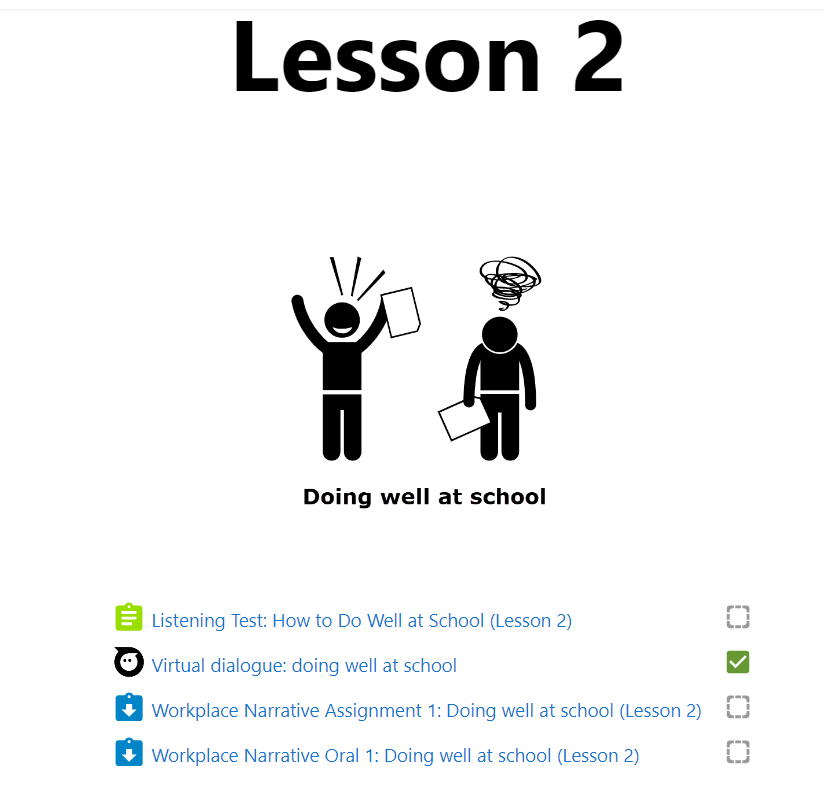
There are 10 topics for 10 weeks of the semester, plus a job interview section with activities to prepare students for 4 job interview questions.
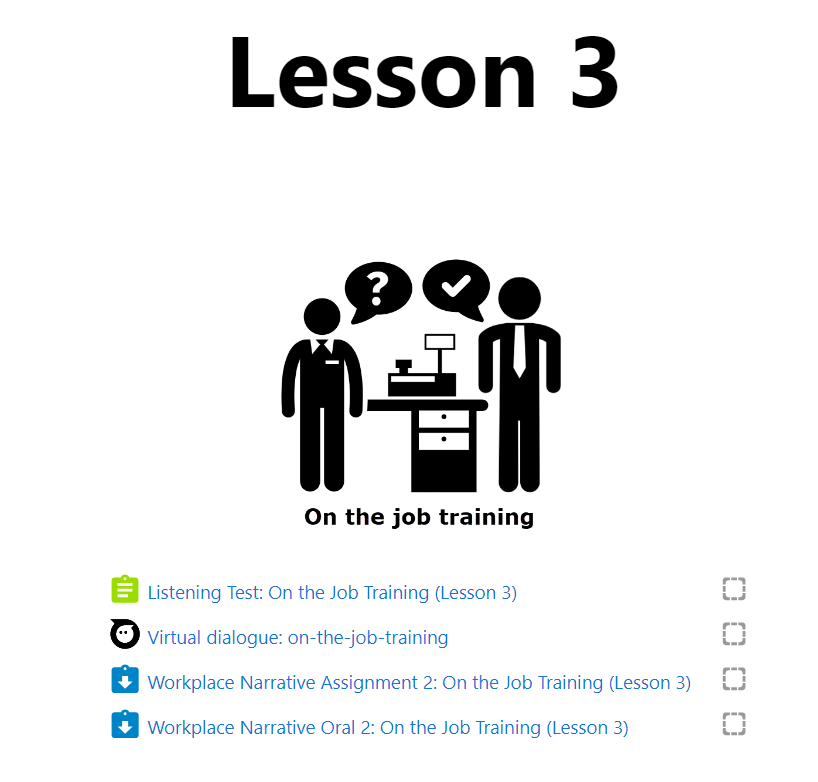
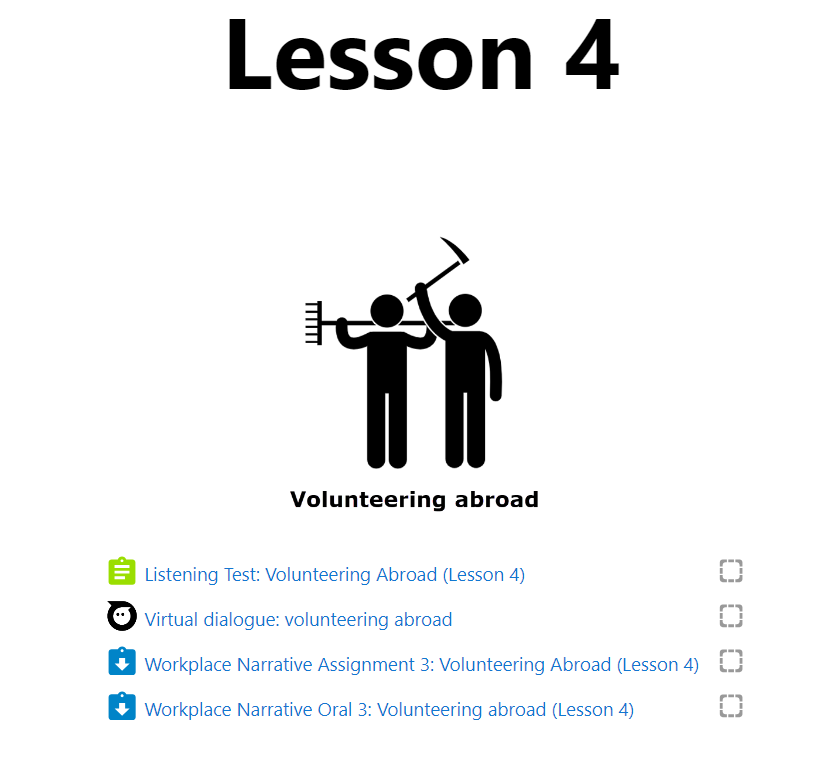
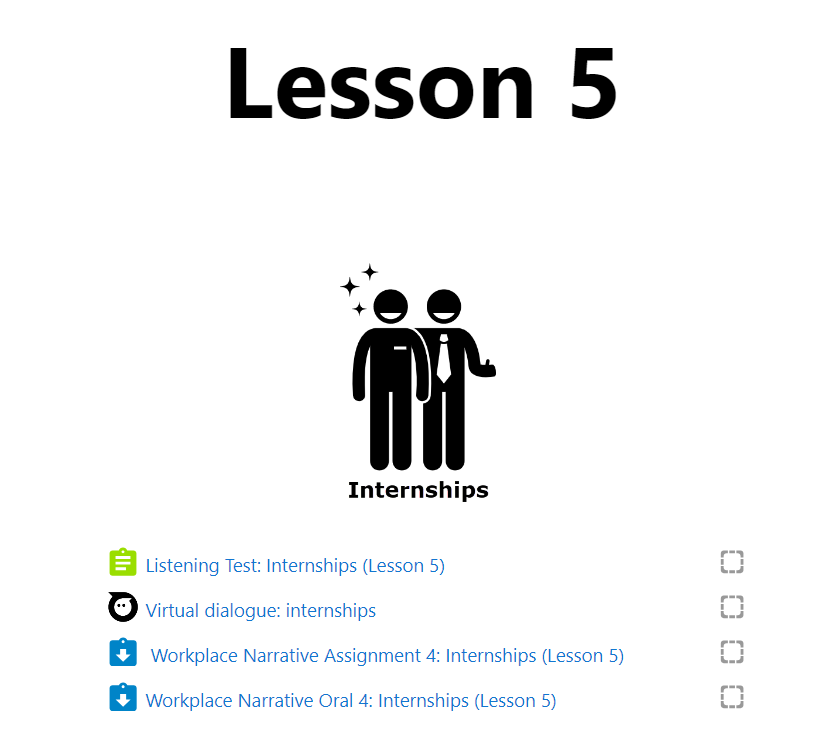
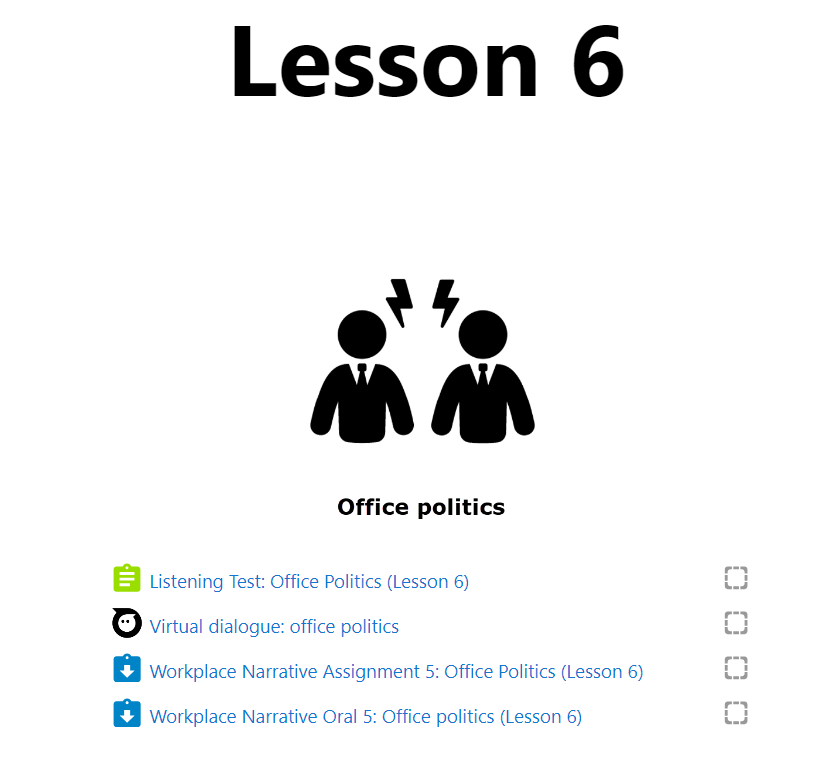
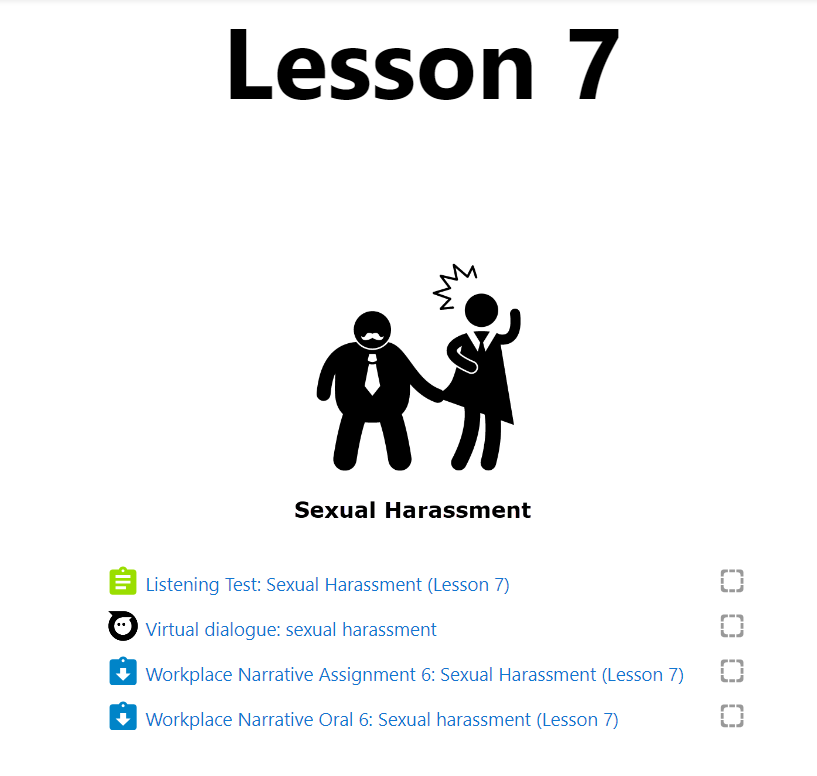
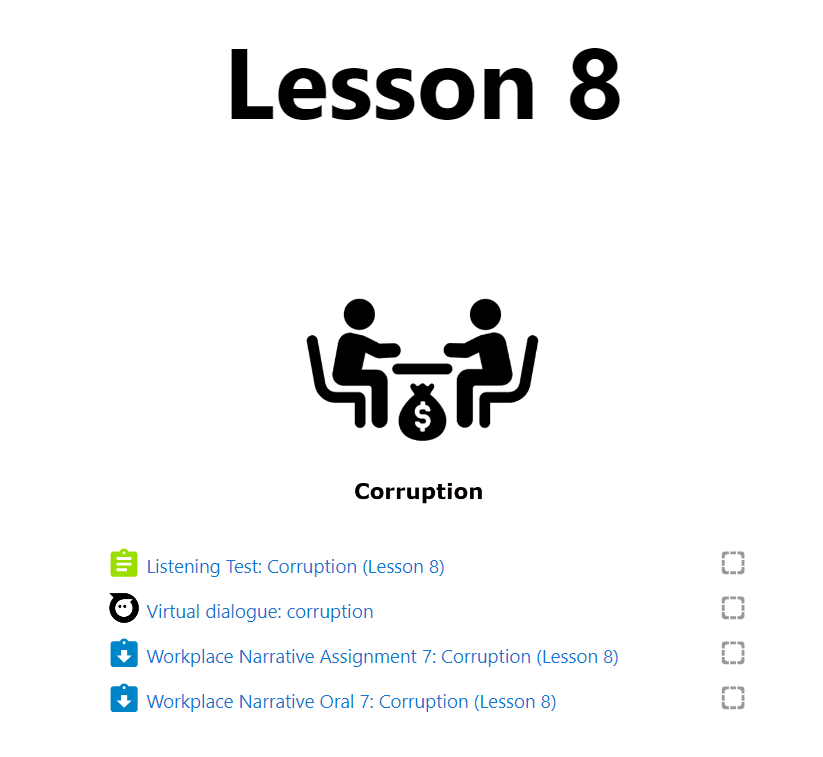
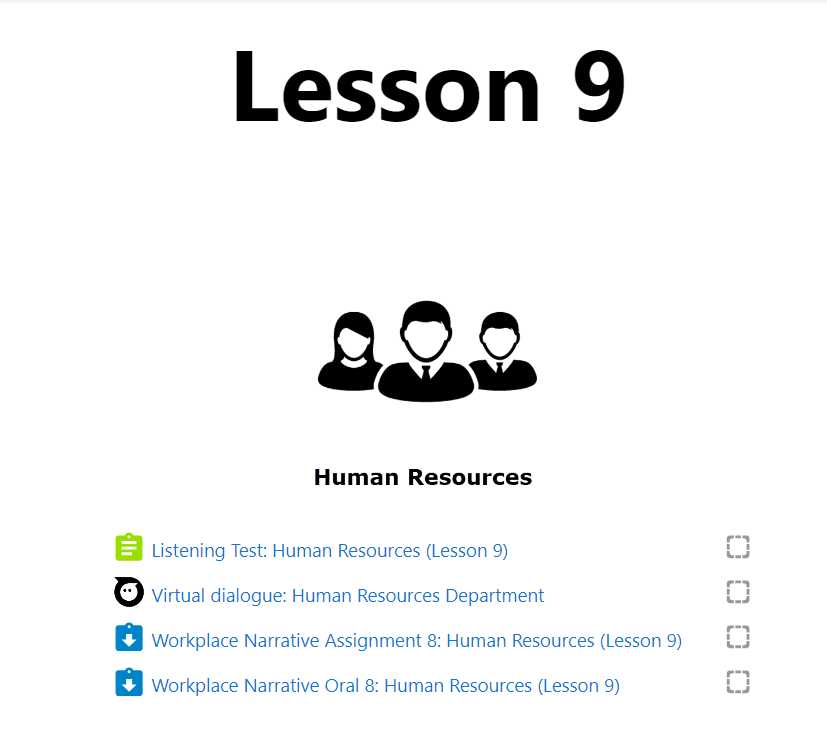
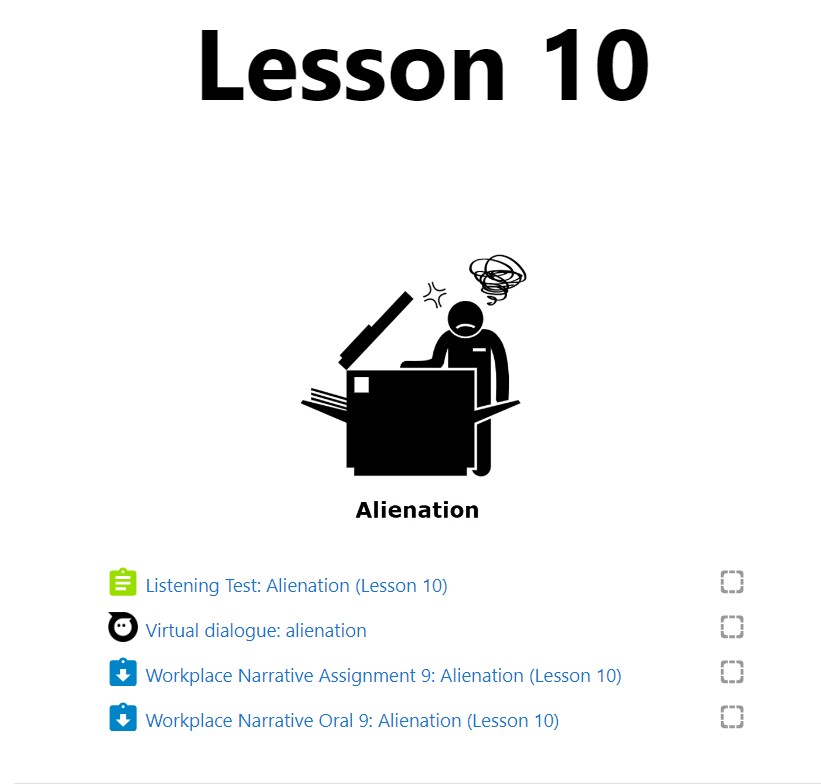

What could go wrong?
You can anticipate some minor difficulties. Students might start a listening quiz, leave before finishing the quiz (hoping to continue it later), but the timer will have expired when they return. They will ask for another attempt. There are two ways to handle this problem. You can enter the list of student attempts and delete attempts to allow a second opportunity to do the quiz, or you can remind the student that only the best scores count — the lowest scores will be removed from the final grade calculation automatically. In other words, “Finish the quiz in one sitting next time.”
With the virtual dialogue activities hosted on ConverSolo.app, students must indicate that they consent to the collection of personal data. Refusing to consent, prevents the student from continuing. There is nothing sinister here. Quebec law requires consent from students when it comes to personal data. Students can withdraw consent any time after they have received their scores, and all of their data will be complete deleted.
With the workplace narrative, some students will attempt to write an opinion piece and be shocked that they have lost points for using the phrase “in my opinion” instead of just telling a story. The feedback is clear on this point. Stories are not essays. They catch on eventually.
With the workplace narrative oral, students sometimes use the integrated microphone on a laptop in a noisy environment and the system will transcribe their words incorrectly because of it. This problem is quite rare and can be solved by using a headset, a smartphone, or a school computer.
Objections
“There are no grammar activities in this course.” It’s true. I can add grammar exercises if you want. I have lots of them. But the error correction feedback in the writing activities will provide plenty of support for grammar learning. The more students write, the more grammar feedback they will receive. If you really want an explicit grammar component, consider putting students in groups of 5 and giving each student a grammar point to research (using ChatGPT!) and then teach to their group. Reciprocal teaching has been shown to accelerate learning by 37% over teacher-center learning (Hattie, 2009). Why? Thinking about the learning needs of others leads to better long term memory encoding (Lieberman, 2013).
“We teach essays.” There’s nothing stopping you from teaching essays. I can even add automated essay evaluation activities if you like. However, the activities provided in this course train students to think imaginatively about their careers as non-literal events. Research has found that stories are more memorable (Hamilton et al. 1980; Graesser et al., 1994; Keenan et al., 1987; Duffy, Shinjo, & Myers, 1990), easier to understand (Graesser et al., 1994), and more interesting (Britton, 1983; Poupore, 2014) than expository or persuasive texts. Students will not complain about storytelling activities. If you get them to share their stories the following week in groups, there will be laughter and smiles all around.
“What if they cheat?” The narrative writing activities come with a ChatGPT detector. If you suspect someone has engaged in GPT plagiarism, click the button and show the student the result. The cheating will stop soon after.
“I like reading and correcting my students’ writing.” There’s nothing stopping you from reading every text your students submit–except time. We know that students can generate much more correction work than teachers can keep up with. So, we have three choices: reduce the number of scored assignments to accommodate the teacher’s capacity to correct them, leave a number of the assignments unscored or peer-assessed, or use automated evaluation. This third option is vastly superior to the first two in terms of accelerating student learning. A degree of letting go of past practices may be warranted in the new age of AI.
“I don’t want my students to have to pay.” A good teacher and good learning materials are good investments. Some things are worth paying for. Education is a very reliable accelerator of wealth and class mobility. Anyway, do the math. Your student will pay more for the cup of coffee he brings to class each week than for this course. The coffee will have no lasting benefit. This course will.
Get this course for your students today!
Simply write an email to bokomarupublications@gmail.com. I will set up your course within 24 hours. There’s no risk. If for any reason you don’t want the course for your students, say so and I will give it to another teacher who wants it. Don’t wait until the semester is about to start if you don’t have to. Use the time now to begin exploring the AI-powered courses on this website today.

